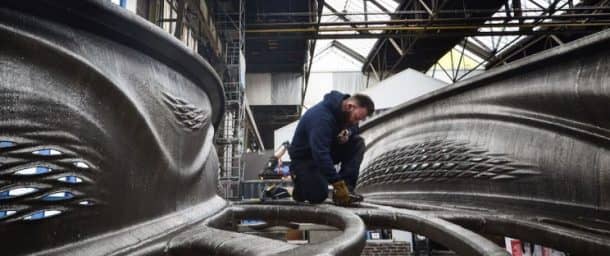MX3D, the Dutch 3D printing firm planned to print a steel bridge back in 2015. This 3D printed steel bridge was to go across Amsterdam’s Oudezijds Achterburgwal canal. The construction of the bridge has finally come to an end but it has not been placed over the water as of yet.
The company used four of its MX3D-Metal robots for the construction of the bridge. These robots consist of a robotic welding arm. The arm lays down a blob of molten metal, then adds another blob on top of it once the previous one has hardened. The process continues until an entire metal column is created.

This is the first of its kind bridge. According to the Imperial College London Steel Structures Research Group, the group in charge of the structural testing of the project, once completed, the bridge will be fitted with sensors that will report data such as strain, displacement, and vibration, as well as environmental factors. It will act as a prototype for future projects and will allow researchers to make the required improvements.
Professor Leroy Gardner, from the Steel Structures Research Group, said, “In the absence of structural design provisions for 3D printed steel, physical testing is an important part of ensuring the safety of the structure. The recent testing confirmed not only that the bridge could withstand the applied load, but also that the numerical simulation of the bridge developed by the Steel Structures Research Group provided an accurate representation of the behaviour observed in practice.”

The completed bridge has the following dimensions: It is 12.5 meters in length and 6.3 meters in width. It is composed of 4,500 kg of stainless steel along with 1,100 km of wire and took six months to print. MX3D originally wanted the 3D printed steel bridge to be made directly over the canal with the robots on one side building their way across but that turned out to be impractical.
“The Oudezijds Achterburgwal where the bridge will be placed is just a too busy place to print,” the company’s Oleg Vishniakou tells us. “There are a lot of pedestrians walking by every day so it would be hard to get a permit for it. Also, you’ll need 24/7 surveillance at the printing site to protect the robots.”

Further tests are being conducted and it is expected to be put in place in 2019. Dr. Craig Buchanan said the team would return to Amsterdam to prove “that the bridge can resist the full design loading it is anticipated to experience when opened to the public in 2019.”
Speaking on the technology’s versatility, Gijs van der Velden, COO of MX3D, has said: “The 3D structure being built by MX3D offers engineers the freedom of working with an entirely new material. The digital twin of the bridge will see the development of a new design language and we hope it will be a significant step in the introduction of this exciting new form of structure into the construction market.”
We will have to wait for a year to see how the bridge actually fares. In the meantime, you can check it out in the video below:


